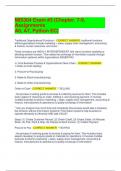Exam (elaborations)
MIS304 Exam #3 (Chapter. 7-9, Assignments A6, A7, Python EC)
MIS304 Exam #3 (Chapter. 7-9, Assignments A6, A7, Python EC) Traditional Organizational Functions - CORRECT ANSWER traditional functions withinorganizations include marketing + sales, supply chain management, accounting & finance, human resources, and more!
[Show more]



